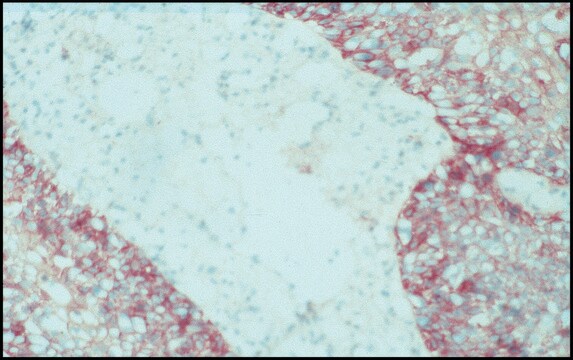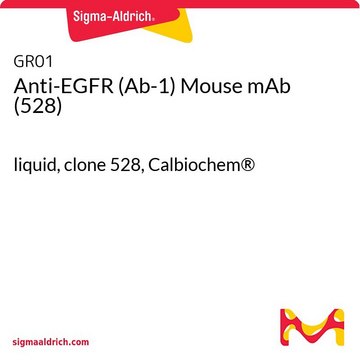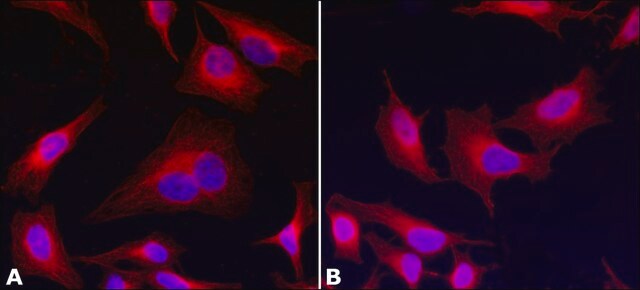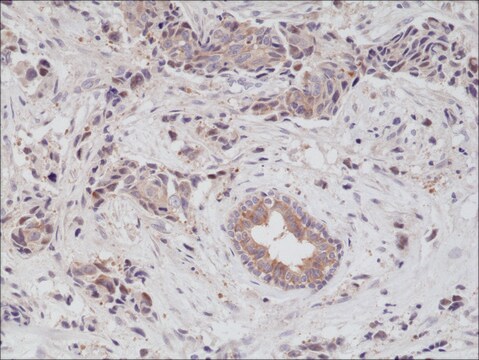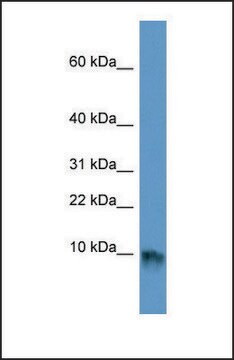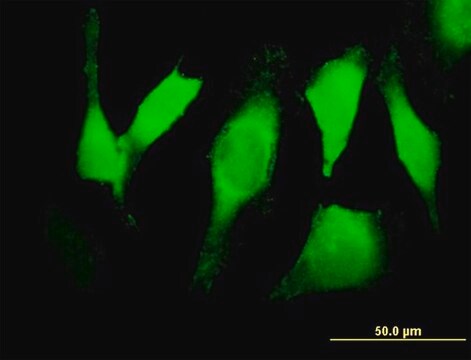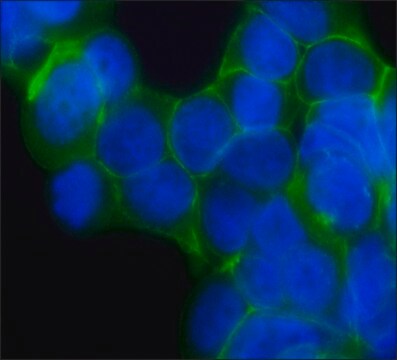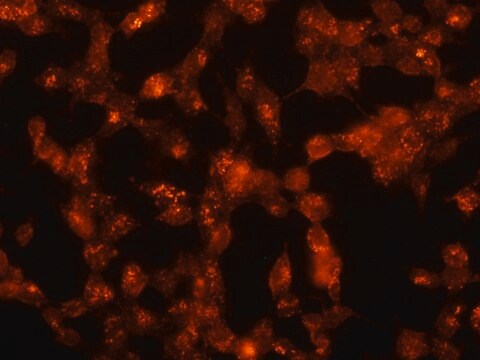E2156
Anti-EGF Receptor antibody, Mouse monoclonal
clone 225, purified from hybridoma cell culture
Synonym(s):
Anti-EGFR, Anti-Epidermal Growth Factor Receptor
Sign Into View Organizational & Contract Pricing
All Photos(1)
About This Item
Recommended Products
biological source
mouse
Quality Level
conjugate
unconjugated
antibody form
purified immunoglobulin
antibody product type
primary antibodies
clone
225, monoclonal
form
buffered aqueous solution
species reactivity
human
concentration
~1.5 mg/mL
technique(s)
immunoprecipitation (IP): 4-8 μg using cell lysate of A431 cells
isotype
IgG1
UniProt accession no.
application(s)
research pathology
shipped in
dry ice
storage temp.
−20°C
target post-translational modification
unmodified
Gene Information
human ... EGFR(1956)
Related Categories
General description
Monoclonal Anti-EGFR (mouse IgG1 isotype) is derived from the hybridoma 225 produced by the fusion of mouse myeloma cells (NS-1-503 cells) and splenocytes from BALB/c mice immunized with partially purified EGF receptors from A-431 cells. The receptor for epidermal growth factor (EGF) is an integral cell membrane glycoprotein of 170 kDa, which spans the membranes of a wide range of normal and malignant epithelial cells. The EGF receptor has an intracellular domain that exhibits tyrosine kinase activity.
Immunogen
partially purified EGF receptors from human A-431 cells.
Application
Monoclonal Anti-EGF Receptor antibody has been used in antibody-nanoparticle conjugation.
Monoclonal Anti-EGF Receptor antibody is suitable for use in immunoprecipitation (4-8 μg using cell lysate of A431 cells).
Biochem/physiol Actions
EGFR (epidermal growth factor receptors) protein tyrosine kinase is activated when EGF binds the extracellular binding domain. The first detectable response is the autophosphorylation of the C-terminal tyrosine followed by phosphorylation of other endogenous substrates.
EGFR is a tyrosine kinase receptor that regulates cellular several functions such as growth, blood vessel formation, metastasis and invasion. Alterations in EGFR expression have been associated with a wide range of cancers. Thus, drugs that target EGFR signaling have important therapeutic applications in cancer .
Physical form
0.2 μm filtered solution in 0.01 M phosphate buffered saline, pH 7.4.
Legal Information
This product is for in vitro research use only. It is not to be used for commercial purposes. Use of this product to produce products for sale or for diagnostic, therapeutic or drug discovery purposes is prohibited. In order to obtain a license to use this product for commercial purposes, contact The Regents of the University of California.
Disclaimer
Unless otherwise stated in our catalog or other company documentation accompanying the product(s), our products are intended for research use only and are not to be used for any other purpose, which includes but is not limited to, unauthorized commercial uses, in vitro diagnostic uses, ex vivo or in vivo therapeutic uses or any type of consumption or application to humans or animals.
Not finding the right product?
Try our Product Selector Tool.
related product
Product No.
Description
Pricing
Storage Class Code
10 - Combustible liquids
Flash Point(F)
Not applicable
Flash Point(C)
Not applicable
Choose from one of the most recent versions:
Already Own This Product?
Find documentation for the products that you have recently purchased in the Document Library.
Kimberly A Homan et al.
ACS nano, 6(1), 641-650 (2011-12-23)
Silver nanoplates are introduced as a new photoacoustic contrast agent that can be easily functionalized for molecular photoacoustic imaging in vivo. Methods are described for synthesis, functionalization, and stabilization of silver nanoplates using biocompatible ("green") reagents. Directional antibody conjugation to
Kevin Seekell et al.
Biomedical optics express, 4(11), 2284-2295 (2013-12-04)
Effective treatment of patients with malignant brain tumors requires surgical resection of a high percentage of the bulk tumor. Surgeons require a method that enables delineation of tumor margins, which are not visually distinct by eye. In this study, the
Kevin Seekell et al.
Journal of biomedical optics, 16(11), 116003-116003 (2011-11-25)
This work presents simultaneous imaging and detection of three different cell receptors using three types of plasmonic nanoparticles (NPs). The size, shape, and composition-dependent scattering profiles of these NPs allow for a system of multiple distinct molecular markers using a
Will J Eldridge et al.
Biomedical optics express, 5(8), 2517-2525 (2014-08-20)
We present a fast, wide-field holography system for detecting photothermally excited gold nanospheres with combined quantitative phase imaging. An interferometric photothermal optical lock-in approach (POLI) is shown to improve SNR for detecting nanoparticles (NPs) on multiple substrates, including a monolayer
Molecular imaging of epidermal growth factor receptor in live cells with refractive index sensitivity using dark-field microspectroscopy and immunotargeted nanoparticles
Curry A C, et al.
Journal of Biomedical Optics, 13(1), 014022-014022 (2008)
Our team of scientists has experience in all areas of research including Life Science, Material Science, Chemical Synthesis, Chromatography, Analytical and many others.
Contact Technical Service